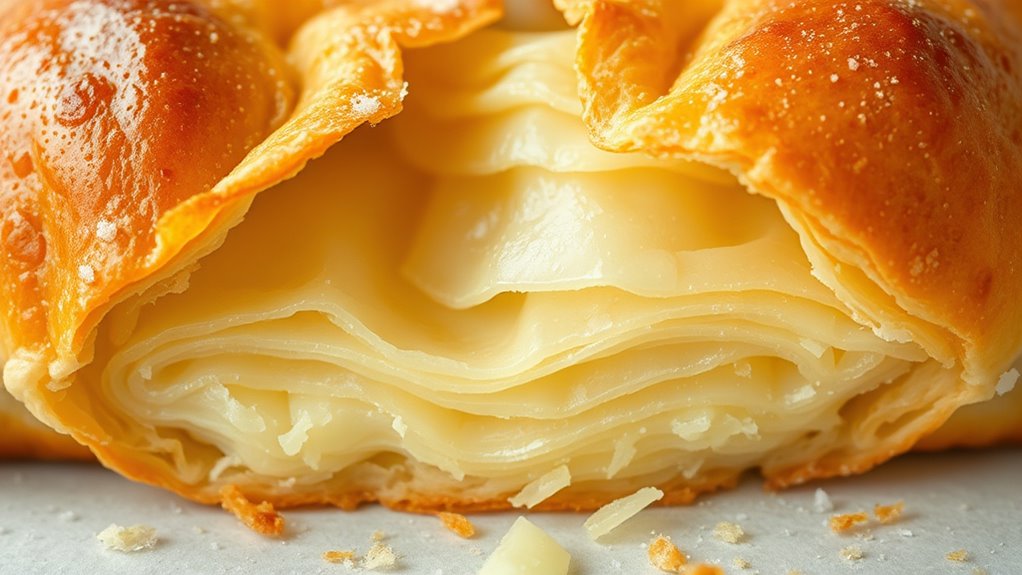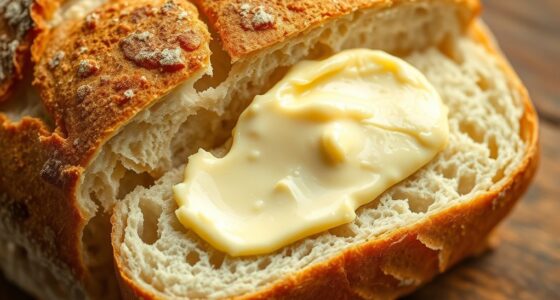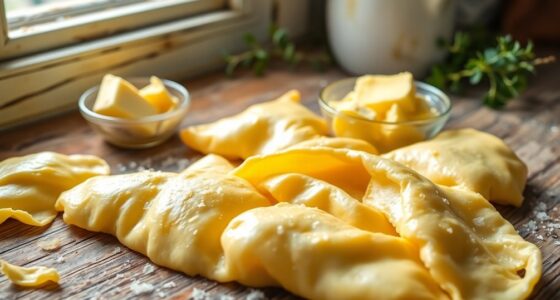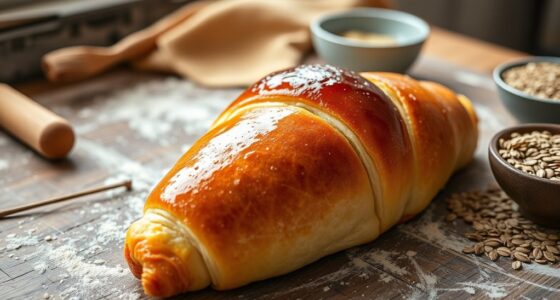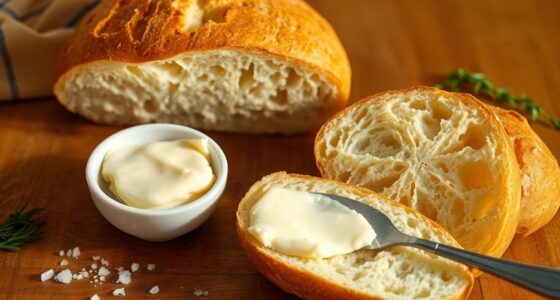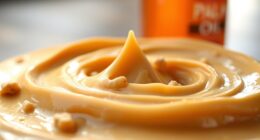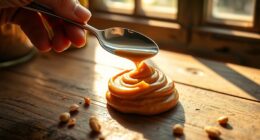The science behind butter lamination that flakes every time comes down to careful temperature control, precise folding, and the interaction between butter and dough. When you keep the butter cold, it stays firm and creates distinct layers by trapping air and moisture, which puff during baking. Proper folding spreads these layers evenly, while resting allows gluten to relax. If you master these techniques, you’ll discover the secrets to perfect flaky layers every bake—more details will reveal how to perfect your process.
Key Takeaways
- Proper butter temperature (cold but pliable) is essential to create distinct, evenly distributed layers without melting into the dough.
- High-fat butter enhances layer separation, puffiness, and creates the flaky texture through effective lamination.
- Consistent folding and rolling trap thin butter layers within the dough, promoting even puffing during baking.
- Resting and chilling of the dough relax gluten and keep butter firm, preventing tearing and ensuring crisp, flaky layers.
- Maintaining molecular bonds between butter and flour during lamination allows layers to puff and separate reliably in the oven.
Understanding the Basics of Puff Pastry and Laminated Dough
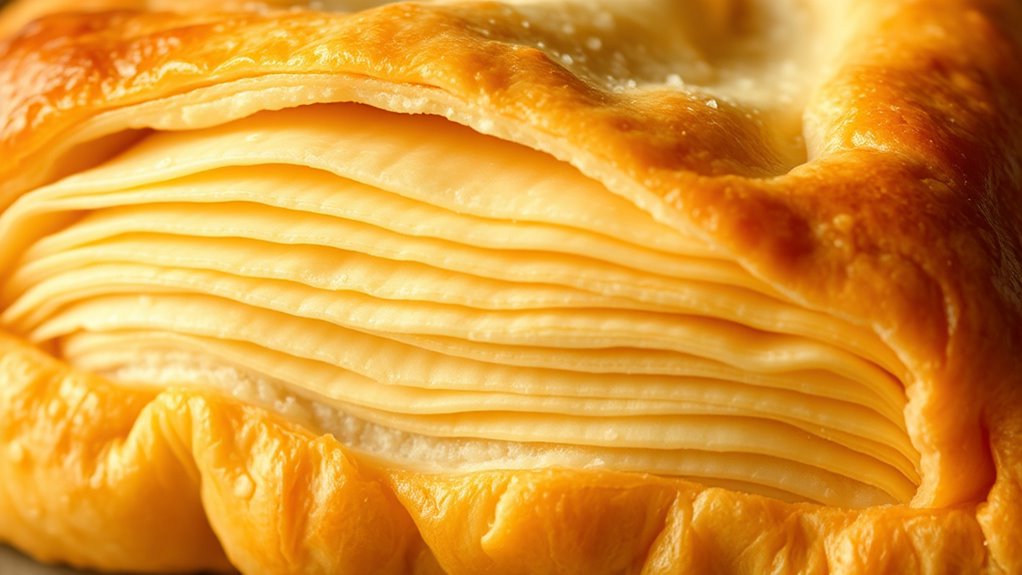
Puff pastry and laminated dough are fundamental in creating flaky, airy pastries, and understanding their basics is essential. These doughs rely on dough elasticity, which allows them to stretch without tearing during the rolling and folding process. Achieving the right elasticity ensures your layers stay intact, resulting in that signature flakiness. The butter flavor is a key element, providing richness and enhancing the dough’s texture. When you work with laminated dough, you repeatedly fold butter into the dough, creating thin layers that puff up when baked. Proper handling of the dough prevents it from becoming too tough or sticky. Mastering these basics sets the foundation for perfect pastries, emphasizing the importance of dough elasticity and the subtle butter flavor that makes laminated pastries irresistible.
The Role of Butter in Creating Flakiness

Butter’s fat content is key to achieving that perfect flakiness, so choosing the right type matters. Controlling the butter’s temperature during incorporation guarantees even layers and prevents melting into the dough. How you mix and handle the butter also influences how crisp and flaky the final pastry turns out. Additionally, understanding high-quality projectors can help in visualizing and refining your pastry presentation.
Butter’s Fat Content
Have you ever wondered why some laminated doughs turn out irresistibly flaky? The key lies in butter’s fat content. Higher fat levels create a richer butter flavor, enhancing the dough’s taste. More importantly, the fat’s melting point affects how the layers separate during baking. When butter melts evenly, it helps form distinct flaky layers by releasing steam and pushing apart the dough. If the fat content is too low, the butter won’t provide enough lubrication or steam, resulting in a less flaky texture. Conversely, too much fat can make the dough greasy and difficult to handle. Striking the right balance ensures that the butter’s fat melts just enough to create those delicate, crisp layers that define perfectly laminated pastries. Additionally, understanding AI security can help bakers develop smarter tools for quality control and consistency.
Temperature Control Techniques
Ever wonder how temperature control influences the flakiness of laminated dough? Keeping butter at the right temperature is essential because it affects butter flavor and dough elasticity. If the butter’s too warm, it’ll become greasy and lose its ability to create distinct layers, reducing flakiness. On the other hand, if it’s too cold, the butter won’t spread evenly, leading to uneven lamination. Maintaining a consistent temperature guarantees the butter remains firm but workable, allowing you to layer it smoothly without melting or cracking. This precise control helps develop the desired dough elasticity, making it easier to roll out and fold without tearing. Proper temperature management also supports the use of natural materials like butter, which are crucial for achieving authentic flaky layers. Ultimately, mastering temperature techniques guarantees the butter stays in perfect condition, resulting in flaky layers that melt in your mouth.
Incorporation Methodology
The way you incorporate butter into laminated dough directly impacts the formation of flaky layers. Achieving the right butter consistency is crucial; it should be cold but pliable, allowing even distribution without melting. If the butter is too soft, it will blend into the dough instead of creating distinct layers, reducing flakiness. Proper folding techniques help trap butter evenly, creating layers that puff up during baking. Oven temperature also plays a vital role—preheating the oven ensures rapid steam generation, which causes the layers to separate and flake. Consistent oven heat helps the butter melt at the right rate, promoting uniform puffiness. Additionally, understanding the lamination process can help bakers refine their technique for perfect layers. By carefully managing butter consistency and oven temperature, you enhance lamination quality, resulting in those delicate, flaky layers every time.
The Science of Lamination: How Layers Form and Persist

Lamination occurs when thin layers of fat or butter are repeatedly folded and rolled, causing the fat to become evenly distributed within the dough. This process relies on molecular interactions, where the fat molecules align and bond with the flour, creating a cohesive structure. As you fold, these interactions strengthen, forming distinct layers that resist merging during baking. Layer stability depends on maintaining these molecular bonds, which keep the layers separate and flaky. When the butter remains solid and well-distributed, it acts as a barrier, preventing the layers from merging. This balance ensures the layers persist through baking, resulting in the characteristic flakiness. Understanding how molecular interactions and layer stability work together helps explain why proper lamination produces those perfect, flaky layers every time. Layer stability is essential for maintaining the separation of layers during baking, ensuring a consistently flaky texture.
Temperature and Its Impact on Butter and Dough Behavior

Temperature plays an essential role in how butter and dough behave during the lamination process. When butter is too cold, its composition becomes firm, making it difficult to spread evenly and risking cracks that can ruin layers. Conversely, if butter is too warm, it softens, blending into the dough and reducing distinct layers. Maintaining the right temperature guarantees butter remains firm yet pliable enough for lamination. This balance influences dough elasticity; properly tempered butter allows the dough to stretch without tearing, facilitating thin, uniform layers. Controlling temperature helps preserve the butter’s ability to create flaky layers, as it keeps the butter separate from the dough, preventing excessive mixing. Additionally, proper temperature management can influence the butter’s consistency, ensuring it maintains its ability to form the desired flaky texture. Ultimately, temperature management is essential for achieving the perfect lamination, resulting in a crisp, flaky pastry every time.
The Technique of Folding and Rolling for Optimal Layers
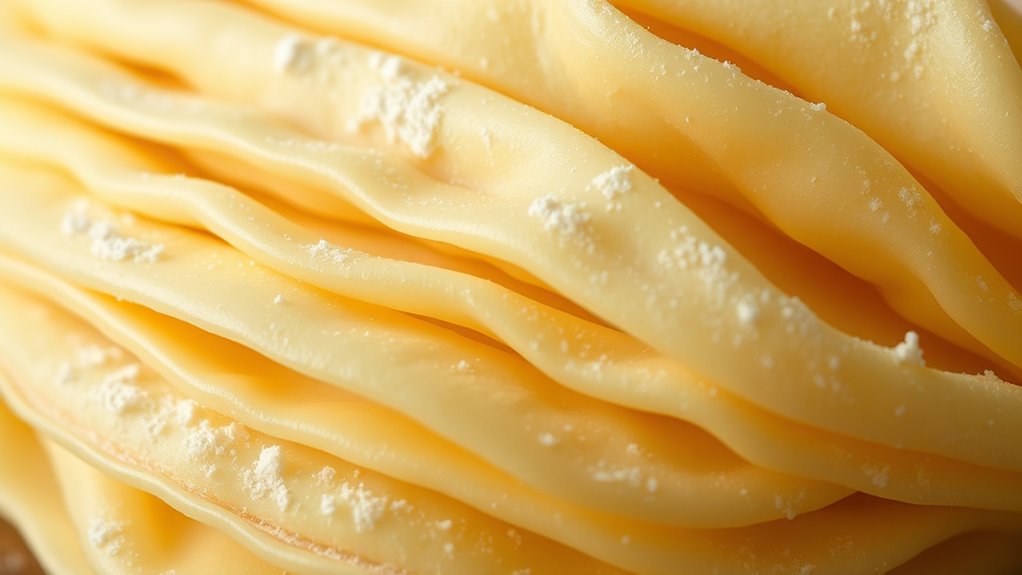
To achieve perfect layers, you need to master precise folding techniques that guarantee even butter distribution. Applying consistent pressure while rolling helps maintain uniform thickness and prevents tearing. Pay close attention to layer alignment, as it directly influences the flaky texture of your final pastry. Additionally, understanding the role of guidance and support in the process can help you develop the skills needed to produce consistently flaky results.
Precise Dough Folding Techniques
Mastering the art of dough folding and rolling is vital for creating the perfect layers in laminated pastries. To achieve this, pay close attention to butter temperature; it should be firm but pliable, guaranteeing even distribution without melting into the dough. Proper dough elasticity is also fundamental—your dough needs to stretch smoothly without tearing during folds. When folding, keep the dough evenly layered, avoiding excessive pressure that can crush the layers or uneven thickness that hampers lamination. Use gentle, consistent movements to maintain the dough’s structure. Rest periods between folds help relax the gluten, making rolling easier and preventing tearing. Precise folding techniques, combined with ideal butter temperature and dough elasticity, ensure your layers remain distinct and flaky, resulting in a perfectly laminated pastry. Additionally, understanding the importance of layer separation and how it contributes to flakiness can significantly improve your lamination process.
Consistent Rolling Pressure
Have you ever noticed how uneven layers can ruin a beautifully laminated pastry? The key is applying consistent rolling pressure. When you roll out your dough, guarantee you use steady, even force each time. This prevents uneven thickness and helps maintain uniform layers. Using high-quality flour can also improve dough elasticity, making it easier to roll out smoothly. Keep the oven temperature in mind too—if your layers aren’t evenly laminated, baking at the right temperature won’t fix the structural inconsistencies. Consistent pressure during rolling helps create thin, even sheets, which are essential for flaky layers that peel apart effortlessly. Practice maintaining steady pressure, and you’ll notice your lamination becomes more reliable, resulting in perfectly flaky pastries every time.
Layer Alignment Strategies
Proper layer alignment is essential for achieving the perfect flaky structure in laminated pastries. To do this, focus on consistent folding and rolling techniques that promote even layer adhesion. When folding, ensure the dough and butter layers are aligned precisely to prevent uneven butter distribution, which can cause weak spots or tearing. Rolling with steady pressure helps maintain uniform thickness, ensuring each layer bonds properly. Avoid stretching or skewing the dough, as misalignment hampers the formation of thin, flaky layers. Pay close attention to how you fold—keeping edges aligned guarantees even butter spread and layer adhesion. This careful technique ensures each fold contributes to the delicate, laminated structure that flakes beautifully when baked, giving you a pastry with suitable layers and texture. Maintaining proper layer alignment throughout the process is critical to achieving consistent flakiness and a professional finish.
The Importance of Resting and Chilling in Lamination

Resting and chilling the dough at key stages during lamination are essential steps that help develop flaky layers and prevent butter from melting into the dough. When the dough is cold, butter stays firm, making it easier to achieve distinct layers. Resting also boosts dough elasticity, allowing it to relax and stretch without tearing, which is crucial for even layering. Chilling between folds prevents the butter from melting prematurely, ensuring that each lamination produces crisp, flaky layers rather than a greasy, fused mass. This process slows down butter melting, giving the dough time to firm up and develop strength. Proper resting and chilling are vital for controlling butter consistency and maintaining the delicate balance needed for perfectly laminated pastry. Additionally, understanding the role of attention in maintaining focus during the process can help ensure consistent results.
Common Mistakes That Can Ruin Flakiness
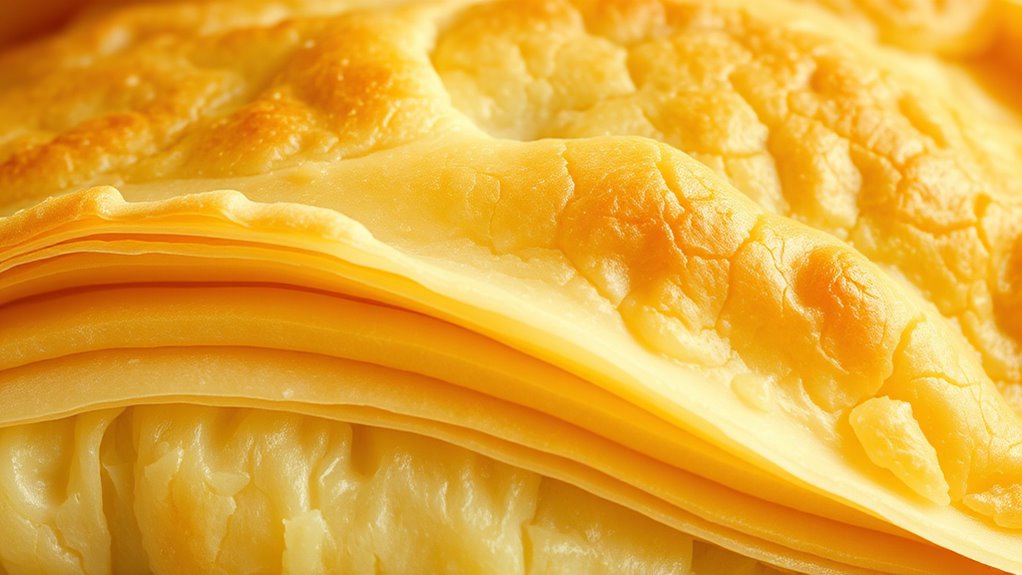
One common mistake that can ruin flakiness is overworking the dough, which develops excess gluten and makes the layers tough rather than tender. When you handle the dough too much, the butter melts into the flour, reducing the distinct layers essential for flaky pastry. Additionally, improper ingredient measurement can throw off the lamination process. If you add too much or too little butter or flour, the dough won’t fold and roll properly, preventing proper layering. Be precise with your measurements and handle the dough as little as possible to maintain its tenderness. Avoid rushing the process or applying too much pressure, as these habits can cause the dough to become dense and less flaky. Staying mindful of these common mistakes helps preserve the delicate, layered structure you aim for.
Tips for Achieving Consistent, Perfect Layers
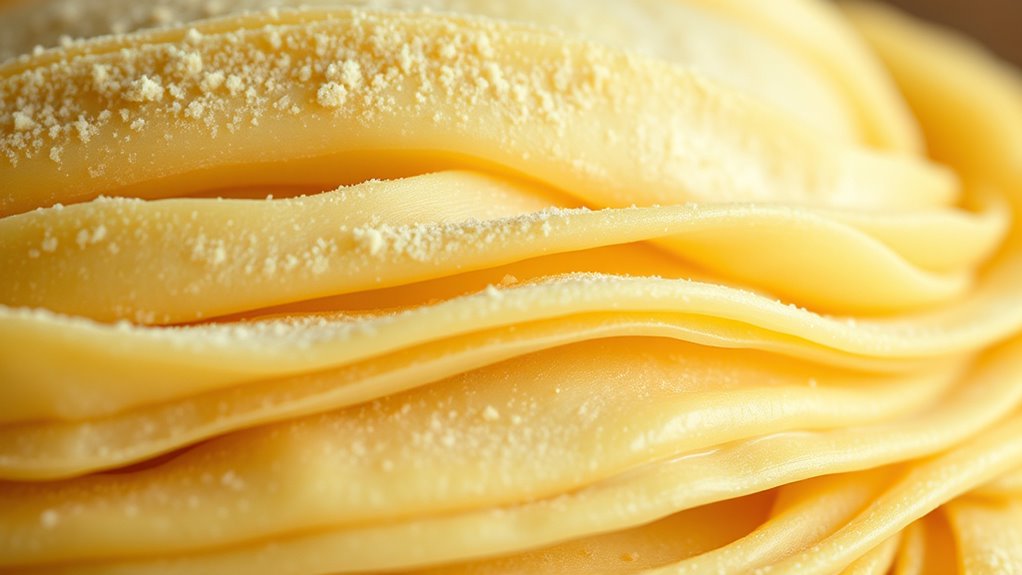
To achieve consistent, perfect layers in your laminated dough, focus on maintaining even thickness throughout each fold and roll. Proper butter layering ensures the butter stays evenly distributed, preventing weak spots or tears. Pay attention to dough elasticity; a well-rested, elastic dough resists tearing and helps create uniform layers. Use a rolling pin to apply gentle, even pressure, avoiding over-flattening. Keep your workspace cool to prevent butter from melting or becoming too soft. The following table highlights key tips:
| Tip | Benefit |
|---|---|
| Use chilled ingredients | Maintains dough elasticity and butter layering |
| Roll with even pressure | Ensures uniform thickness |
| Rest dough adequately | Improves elasticity and layering |
| Monitor butter temperature | Prevents melting and uneven layers |
Consistency comes from practice and attention to detail.
Scientific Insights Into Baking and Baking Environment Factors
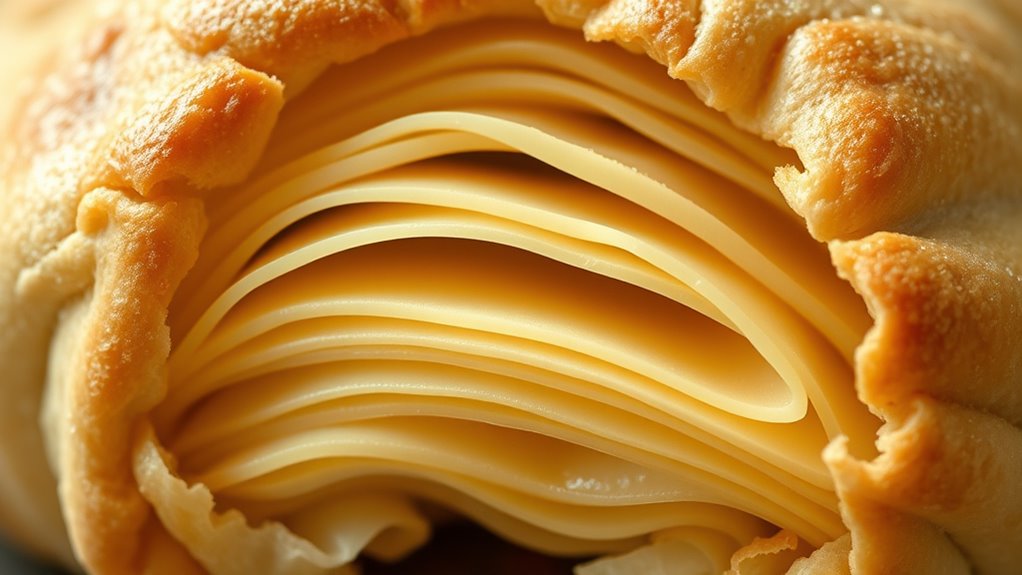
Understanding how temperature, humidity, and air circulation influence baking can help you optimize your results. The butter composition plays a vital role; the fat and moisture levels affect how butter melts and interacts with dough layers. In a warm baking environment, butter softens quickly, risking over-mixing or uneven lamination. High humidity can slow moisture evaporation, leading to softer dough and potentially less flaky layers. Proper air circulation ensures even heat distribution, preventing hot spots that can melt butter too rapidly. By controlling your baking environment—maintaining consistent temperature and humidity—you can better manage how butter behaves during lamination. This precision allows you to create distinct, flaky layers every time, highlighting the significance of understanding these scientific factors in achieving perfect butter laminations.
Frequently Asked Questions
How Does Humidity Affect Butter Lamination Quality?
Humidity plays a vital role in butter lamination quality. When humidity levels are high, butter moisture can increase, leading to softer layers that struggle to stay crisp and flaky. Conversely, low humidity helps control butter moisture, resulting in firmer layers that laminate better. To achieve perfect lamination, you need to maintain humidity control, ensuring the butter remains at an ideal moisture level for crisp, flaky pastries every time.
Can Different Types of Butter Influence Flakiness?
Think of butter as the soul of your flaky pastry; different types influence flakiness like a painter choosing vibrant colors. Your choice affects butter composition, which impacts how well layers separate during baking. Some butters have higher fat content, creating more tender, flaky layers, while others bring flavor variations that enhance your pastry’s taste. Using the right butter can turn an ordinary bake into a masterpiece, with perfect, crisp flakiness.
What Role Does Flour Type Play in Lamination Success?
You should consider how flour type impacts lamination success because flour protein levels directly influence gluten development. High-protein flours create stronger gluten networks, making the dough more elastic and easier to roll out thin without tearing. Conversely, low-protein flours yield softer doughs that are less resilient. Choosing the right flour helps you achieve flaky layers, as ideal gluten development allows for better layering and precise butter incorporation.
How Do Altitude and Pressure Impact Puff Pastry Layers?
Altitude effects and pressure variations considerably influence puff pastry layers. Higher altitudes reduce atmospheric pressure, causing dough to rise faster and potentially flake less evenly. Conversely, lower altitudes with increased pressure can slow down expansion, leading to denser layers. You need to adjust your recipe by altering ingredients or baking times to account for these factors, ensuring your layers stay flaky and well-defined regardless of altitude or pressure changes.
Are There Natural Additives That Improve Layer Stability?
You can improve layer stability by using natural additives that act as preservatives, helping the dough maintain its structure. Natural preservatives like honey, vinegar, or lemon juice enhance additive stability, preventing the layers from collapsing or becoming soggy. These ingredients support the dough’s elasticity and moisture balance, making your puff pastry more reliable. Incorporating such natural additives guarantees consistent lamination results and a flakier, more stable pastry every time.
Conclusion
Mastering butter lamination is like baking a puzzle—you need patience, precision, and attention to detail. When you understand the science behind layers, temperature, and technique, flakey pastries become second nature. Remember, a chain is only as strong as its weakest link; so, don’t rush the resting and chilling steps. With practice, you’ll turn simple ingredients into flaky masterpieces, proving that patience and care truly make perfect layers every time.
